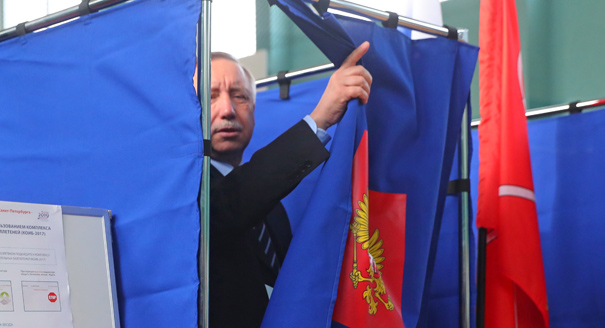A proper assessment of the election for governor of Russia’s second city, St. Petersburg, on September 8 requires a look back to the previous election in 2014, when Georgy Poltavchenko was elected. It’s an important comparison, because the scenarios for both campaigns were identical.
Firstly, both Poltavchenko and his successor Alexander Beglov, though they clearly have very different personalities (Poltavchenko was a reserved introvert, while Beglov loves being in the public eye), belong to the same ilk of old-school officials. It’s difficult to say much about them personally; they are simply bureaucrats, and both positive and negative opinions of them are entirely a result of their professional position.
Like Poltavchenko before him, Beglov ran a boring campaign against three rival candidates selected by a careful filtration process: Nadezhda Tikhonova for A Just Russia (a relative of Sergei Mironov, the party’s head); Mikhail Amosov, a skilled orator but uncharismatic moderate democrat running for the Civic Platform party; and the film director Vladimir Bortko, representing the Communist Party. Bortko put up a lot of campaign billboards, and having a certain amount of fame at his disposal, as well as a party brand behind him, could have taken second place with a decent showing.
Everything progressed in a dull and orderly way until Bortko suddenly withdrew his candidacy during a televised debate with just a week to go until the election. “The cards are marked, there are five aces in the pack,” he complained, announcing his decision.
With Bortko’s withdrawal, a little intrigue was returned to the election: that of who would take second place now, since Amosov and Tikhonova had similarly abysmal ratings (4 percent and 3 percent, respectively, according to the only poll published on the subject).
A boring campaign, bloodless rivals, a lack of fatal mistakes that could have enraged voters: it seemed that Beglov was on track to repeat the triumphant result of Poltavchenko, who won the 2014 election with 79.3 percent of the vote amid a turnout of 39 percent.
Nor was there any real mood of protest in the city. An authorized rally held there to show solidarity after the Moscow protests were brutally put down only attracted about 2,000 people.
Against this backdrop, it seemed that Bortko’s withdrawal from the race was excessive caution on the part of City Hall. Now, however, it is clear that this was the right decision. When 99.26 percent of the vote had been counted, Beglov had 64.46 percent, Tikhonova had 16.85 percent, and Amosov had 16.01 percent. That means that less than 2 percent of the ballot papers were invalid. In other words, far more voters resorted to tactical voting than chose to spoil their ballot papers in protest against all of the candidates.
The near-identical results of Amosov and Tikhonova show once again that people were following the tactic of voting for anyone except Beglov, and that left with two other options, voters simply tossed a coin. For the first time in the history of the city, without any major external factors—without even the factor of pension reform that was so unpopular last fall—we have seen clearly expressed protest voting.
Back in the summer, City Hall provoked a scandal when it decided to set up polling stations in the Pskov region, to enable St. Petersburgers who might be staying at their dachas there at the time of the election to vote. Even the Central Election Commission complained about these extra stations, stating publicly that some of the requests from voters for their creation were fake. The city electoral commission reduced the number of booths in the Pskov region from twenty to fifteen in response.
It’s likely that this interest in the Pskov region stems from the fact that one of the managers of Beglov’s campaign previously worked on the Pskov governor’s campaign, and has retained useful assets there. Yet the number of extra votes that Beglov got thanks to this idea (a total of 43,000 people voted at these out-of-town stations) was clearly not worth the blow to his image.
It is telling that the final voter turnout was only announced during the day on Monday, though in theory, it should have been known soon after the polls closed on Sunday. Usually, a delay in information being released is a sign that the final figures are being approved by someone. In the St. Petersburg election, turnout was extremely low: 30.08 percent. Had Bortko not dropped out, a runoff would have been entirely possible.
Unlike the predetermined gubernatorial election, the municipal elections elicited real interest from the opposition, with the liberal Yabloko party; prominent opposition activist Andrei Pivovarov and ex-Duma deputy Dmitry Gudkov; and opposition leader Alexei Navalny all forming and backing their own teams of people who ran in elections for municipal councils across the city. In some districts, they were joined by the in-system opposition: A Just Russia and the Party of Growth, represented in St. Petersburg by Oksana Dmitrieva, a former minister and high-profile figure in St. Petersburg.
Overall, the final picture was the same as in the previous elections in 2014, which ended in the total defeat of all opposition candidates. But candidates representing Yabloko, A Just Russia, and those backed by Navalny did win half the seats on Vasilyevsky Island, one of the city’s central districts. In addition, several municipal councils have come under the control of A Just Russia and the Party of Growth in other districts. Starting as they did with practically nothing (before the elections, there was just one municipal council not under the control of United Russia), any positive result for the opposition is a noteworthy victory.
